Hubble's 28th birthday picture: The Lagoon Nebula
Infrared view of the Lagoon Nebula
Videos
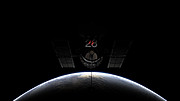
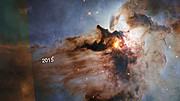
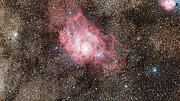
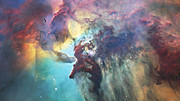
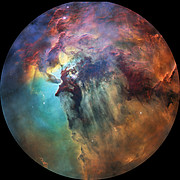
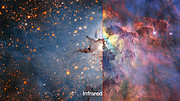
Mathias Jäger

Hubblecast 109: Diving into the Lagoon Nebula

The centre of the Lagoon Nebula over time

Diving into the Lagoon Nebula

Swimming across the Lagoon Nebula

Fulldome view of the Lagoon Nebula

This colourful cloud of glowing
interstellar gas is just a tiny part of the Lagoon Nebula, a vast
stellar nursery. This nebula is a region full of intense activity, with
fierce winds from hot stars, swirling chimneys of gas, and energetic
star formation all embedded within a hazy labyrinth of gas and dust.
Hubble used both its optical and infrared instruments to study the
nebula, which was observed to celebrate Hubble’s 28th anniversary.
Since its launch on 24 April 1990, the NASA/ESA Hubble Space Telescope
has revolutionised almost every area of observational astronomy. It has
offered a new view of the Universe and has reached and surpassed all
expectations for a remarkable 28 years. To celebrate Hubble’s legacy and
the long international partnership that makes it possible, each year
ESA and NASA celebrate the telescope’s birthday with a spectacular new
image. This year’s anniversary image features an object that has already
been observed several times in the past: the Lagoon Nebula.
The Lagoon Nebula
is a colossal object 55 light-year wide and 20 light-years tall. Even
though it is about 4000 light-years away from Earth, it is three times
larger in the sky than the full Moon. It is even visible to the naked
eye in clear, dark skies. Since it is relatively huge on the night sky,
Hubble is only able to capture a small fraction of the total nebula.
This image is only about four light-years across, but it shows stunning
details.
The inspiration for this nebula’s name may not be immediately obvious
in this image. It becomes clearer only in a wider field of view, when
the broad, lagoon-shaped dust lane that crosses the glowing gas of the
nebula can be made out. This new image, however, depicts a scene at the
very heart of the nebula.
Like many stellar nurseries, the nebula boasts many large, hot stars. Their ultraviolet radiation ionises
the surrounding gas, causing it to shine brightly and sculpting it into
ghostly and other-worldly shapes. The bright star embedded in dark
clouds at the centre of the image is Herschel 36. Its radiation sculpts the surrounding cloud by blowing some of the gas away, creating dense and less dense regions.
Among the sculptures created by Herschel 36 are two interstellar
twisters — eerie, rope-like structures that each measure half a
light-year in length. These features are quite similar to their
namesakes on Earth — they are thought to be wrapped into their
funnel-like shapes by temperature differences between the hot surfaces
and cold interiors of the clouds. At some point in the future, these
clouds will collapse under their own weight and give birth to a new
generation of stars.
Hubble observed the Lagoon Nebula not only in visible light but also
at infrared wavelengths. While the observations in the optical allow
astronomers to study the gas in full detail, the infrared light cuts
through the obscuring patches of dust and gas, revealing the more
intricate structures underneath and the young stars hiding within it.
Only by combining optical and infrared data can astronomers paint a
complete picture of the ongoing processes in the nebula.
More Information
The Hubble Space Telescope is a project of international cooperation between ESA and NASA.
Image credit: NASA, ESA, STScI
Links
- Images of Hubble
- Hubblesite release
- Hubble image of the Lagoon Nebula (2015)
- Hubble image of the Lagoon Nebula (2011)
- Hubble image of the Lagoon Nebula (2010)
- Hubble image of the Lagoon Nebula (1996)
Contacts
Mathias Jäger
ESA/Hubble, Public Information Officer
Garching bei München, Germany
Tel: +49 176 62397500
Email: mjaeger@partner.eso.org
Source: ESA/Hubble/News



